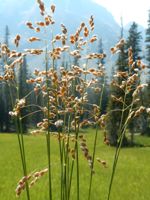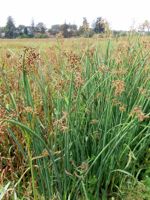Mon-Fri 9am - 5pm Mountain time
Sweetgrass vs Softstem Bulrush
Anthoxanthum hirtum/Anthoxanthum nitens (Hierochloe odorata))
Schoenoplectus tabernaemontani
CUSTOM GROW
CUSTOM GROW
Sweetgrass is a cool-season perennial grass best known for its sweet, vanilla-like fragrance. The scent comes from coumarin in the leaves, which is pleasant to humans but has a bitter taste that makes the plant less appealing to deer and other herbivores. As a cool-season grass, Sweetgrass grows most vigorously in spring and fall, slowing or even going dormant during the heat of summer.
It spreads quickly through creeping rhizomes and can be difficult to remove once established, so it is best planted in areas where its spread will not cause problems. Due to its deep, vigorous root system and preference for moist soils, Sweetgrass is especially useful for erosion control, soil stabilization, riparian plantings, and naturalization projects.
Note: Sweetgrass was formerly classified under the scientific name Hierochloe odorata and its subspecies. The subspecies found in Canada are currently considered two distinct species: Anthoxanthum hirtum, which is native across Canada, and Anthoxanthum nitens, which is native to Eastern Canada. Because these two species are alike and share many overlapping common names, they are often considered as only one species.
Softstem Bulrush is a native perennial sedge that forms dense colonies of tall, upright stems. Thriving in saturated soils and shallow water, it spreads vigorously by rhizomes, creating large colonies that stabilize shorelines, control erosion, and strengthen wetland ecosystems.
Dense stands of Softstem Bulrush create shelter and nesting sites for birds, while also supporting aquatic invertebrates and the larvae of numerous insects. It is also an important food source. Many wetland birds, especially ducks, feed on the seeds, while muskrats feed on the foliage and rhizomes. Well-suited for ecological restoration, waterside & riparian plantings, erosion control, and habitat enhancement projects.
Sweetgrass Quick Facts
Softstem Bulrush Quick Facts
Toxicity: toxic if large amounts ingested

